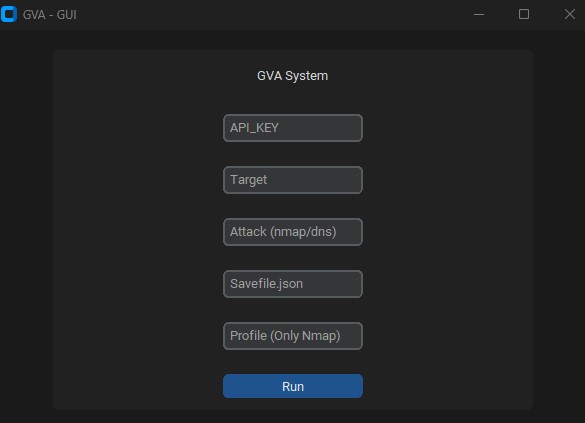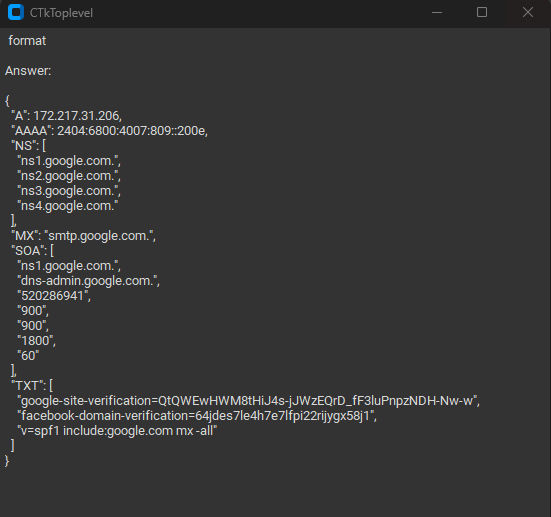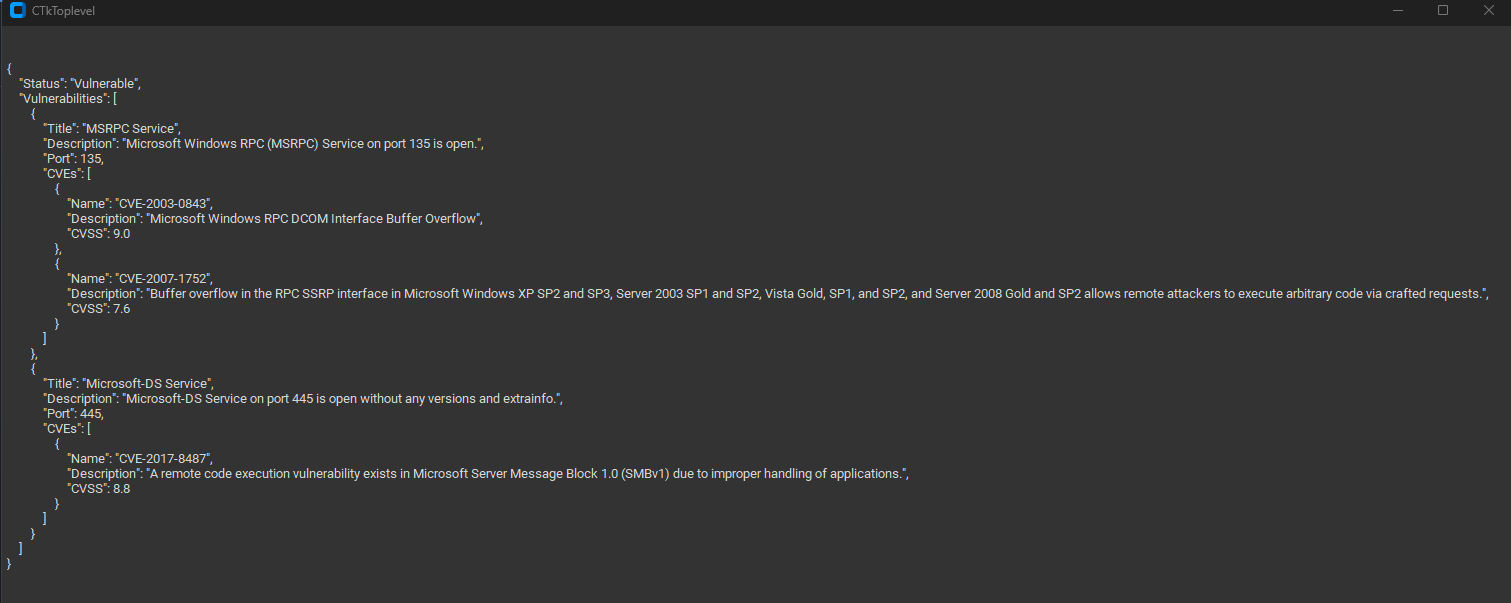This is a Proof Of Concept application that demostrates how AI can be used to generate accurate results for vulnerability analysis and also allows further utilization of the already super useful ChatGPT made using openai-api, python-nmap, dnsresolver python modules and also use customtkinter and tkinter for the GUI version of the code. This project also has a CLI and a GUI interface, It is capable of doing network vulnerability analysis, DNS enumeration and also subdomain enumeration.
- Python 3.10
- All the packages mentioned in the requirements.txt file
- OpenAi api
- First Change the "API__KEY" part of the code with OpenAI api key
openai.api_key = "__API__KEY__" # Enter your API key- second install the packages
pip3 install -r requirements.txt
or
pip install -r requirements.txt- run the code python3 gpt_vuln.py
# Regular Help Menu
python gpt_vuln.py --help
# Rich Help Menu
python get_vuln.py --r help
# Specify target with the attack
python gpt_vuln.py --target <IP> --attack dns/nmap
# Specify target and profile for nmap
python get_vuln.py --target <IP> --attack nmap --profile <1-5>
(Default:1)
# Specify target for DNS no profile needed
python get_vuln.py --target <IP or HOSTNAME> --attack dns
# Specify target for Subdomain Enumeration no profile needed
python get_vuln.py --target <HOSTNAME> --attack subSupported in both windows and linux
Profiles:
| Parameter | Return data | Description | Nmap Command |
|---|---|---|---|
p1 |
json |
Effective Scan | -Pn -sV -T4 -O -F |
p2 |
json |
Simple Scan | -Pn -T4 -A -v |
p3 |
json |
Low Power Scan | -Pn -sS -sU -T4 -A -v |
p4 |
json |
Partial Intense Scan | -Pn -p- -T4 -A -v |
p5 |
json |
Complete Intense Scan | -Pn -sS -sU -T4 -A -PE -PP -PS80,443 -PA3389 -PU40125 -PY -g 53 --script=vuln |
The profile is the type of scan that will be executed by the nmap subprocess. The Ip or target will be provided via argparse. At first the custom nmap scan is run which has all the curcial arguments for the scan to continue. nextly the scan data is extracted from the huge pile of data which has been driven by nmap. the "scan" object has a list of sub data under "tcp" each labled according to the ports opened. once the data is extracted the data is sent to openai API davenci model via a prompt. the prompt specifically asks for an JSON output and the data also to be used in a certain manner.
The entire structure of request that has to be sent to the openai API is designed in the completion section of the Program.
def profile(ip):
nm.scan('{}'.format(ip), arguments='-Pn -sS -sU -T4 -A -PE -PP -PS80,443 -PA3389 -PU40125 -PY -g 53 --script=vuln')
json_data = nm.analyse_nmap_xml_scan()
analize = json_data["scan"]
# Prompt about what the quary is all about
prompt = "do a vulnerability analysis of {} and return a vulnerabilty report in json".format(analize)
# A structure for the request
completion = openai.Completion.create(
engine=model_engine,
prompt=prompt,
max_tokens=1024,
n=1,
stop=None,
)
response = completion.choices[0].text
return responsenmap output:
{
"Vulnerability Report": {
"Target IP": "127.0.0.1",
"OS Detected": {
"Name": "Microsoft Windows 10 1607",
"Accuracy": "100",
"CPE": [
"cpe:/o:microsoft:windows_10:1607"
]
},
"Open Ports": {
"Port 135": {
"State": "open",
"Reason": "syn-ack",
"Name": "msrpc",
"Product": "Microsoft Windows RPC",
"Version": "",
"Extra Info": "",
"Conf": "10",
"CPE": "cpe:/o:microsoft:windows"
},
"Port 445": {
"State": "open",
"Reason": "syn-ack",
"Name": "microsoft-ds",
"Product": "",
"Version": "",
"Extra Info": "",
"Conf": "3",
"CPE": ""
}
},
"Vulnerabilities": {
"Port 135": [],
"Port 445": []
}
}
}DNS Output: target is google.com
{
"A" : {
"ip": "142.250.195.174",
},
"AAAA": {
"ip": "2404:6800:4007:826::200e"
},
"NS": {
"nameservers": [
"ns2.google.com.",
"ns1.google.com.",
"ns3.google.com.",
"ns4.google.com."
]
},
"MX" : {
"smtp": "10 smtp.google.com."
},
"SOA" : {
"nameserver": "ns1.google.com.",
"admin": "dns-admin.google.com.",
"serial": "519979037",
"refresh": "900",
"retry": "900",
"expire": "1800",
"ttl": "60"
},
"TXT": {
"onetrust-domain-verification": "de01ed21f2fa4d8781cbc3ffb89cf4ef",
"webexdomainverification.8YX6G": "6e6922db-e3e6-4a36-904e-a805c28087fa",
"globalsign-smime-dv": "CDYX+XFHUw2wml6/Gb8+59BsH31KzUr6c1l2BPvqKX8=",
"google-site-verification": [
"wD8N7i1JTNTkezJ49swvWW48f8_9xveREV4oB-0Hf5o",
"TV9-DBe4R80X4v0M4U_bd_J9cpOJM0nikft0jAgjmsQ"
],
"docusign": [
"05958488-4752-4ef2-95eb-aa7ba8a3bd0e",
"1b0a6754-49b1-4db5-8540-d2c12664b289"
],
"atlassian-domain-verification": "5YjTmWmjI92ewqkx2oXmBaD60Td9zWon9r6eakvHX6B77zzkFQto8PQ9QsKnbf4I",
"v=spf1 include:_spf.google.com ~all": "v=spf1 include:_spf.google.com ~all",
"facebook-domain-verification": "22rm551cu4k0ab0bxsw536tlds4h95",
"MS=E4A68B9AB2BB9670BCE15412F62916164C0B20BB": "MS=E4A68B9AB2BB9670BCE15412F62916164C0B20BB",
"apple-domain-verification": "30afIBcvSuDV2PLX"
}
}The GUI uses customtkinter for the running of the code. The interface is straight forward the only thing required to remember is:
- When using dns attack dont specify the profile
python GVA_gui.py- Can be used in developing a more advanced systems completly made of the API and scanner combination
- Has the capability to analize DNS information and reslove Mustiple records it a more better format.
- Can increase the effectiveness of the final system
- Can also perform subdomain enumeration
- Highly productive when working with models such as GPT3


